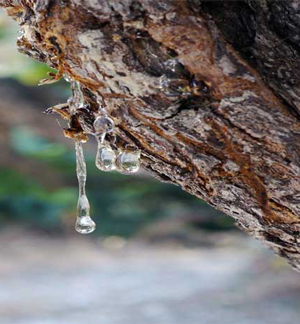
Mastic: The "tears of Chios"
Mastic is a resin obtained from the mastic tree! In Greece it is known as the "tears of Chios," being traditionally produced on that Greek island, and, like other natural resins is produced in "tears" or droplets. Originally liquid, it is sun-dried into drops of hard brittle translucent resin. When chewed, the resin softens and becomes a bright white and opaque gum. It’s unique aroma and it’s know nutrition values have made mastic travel all over the world since the ancient times! Today besides the simple gum, mastic is used in innumerable products such as cosmetics and body lotions, food spices, baked goods, soaps, liqueurs and even mastiha flavored coffee! The next time you are in Greece don’t forget to taste the unique mastiha and discover its amazing values for the human body! (Tip: It also makes an excellent gift for your friends back home!) Μastic: as a Spice, a Natural Gum or as a Medicine Greeks call the mastic tree, Pistachio lentiscus, the tree that "cries," for the way the trunks are slashed in order to liberate the crystal like resin within. It is that resin - mastic- that has captured the fancy of cooks, doctors and traders for hundreds, if not thousands, of years. In Greece, mastic is produced exclusively in one of the 21 mastic towns on the island of Hios. There are over 2 million mastic trees on the island, and more than five thousand families are involved in the production. Today, mastic is used as a spice, a natural gum, and is also valued for its pharmaceutical properties -the resin has been shown to help heal stomach ulcers, among other ailments. The resin is collected twice a year, in July and then again in the late summer-early fall. The ground under the trees is swept clean and a layer of lime is spread over it, to facilitate harvesting. The tree trunks are slashed and the resin slowly oozes out, falling onto the lime-covered soil in drops. Over the course of a month or so, when enough drops fall to form small, glass-like pies, the mastic is then collected, cleaned and processed. Hios is renowned all over the world for its unique natural gum, mastic. Mastic was used for pharmaceutical purposes, to heal snake bites, stomach ailments, and more, from as far back as ancient times. The substance was noted for its medicinal use by Hippocrates, Theophrastus, Dioskourides and others. Mastic was prized by the Pharaohs, as well as by the Romans, who made toothpicks with it. It wasn't, however, until the 10th century that mastic became a prized commodity. The Genoese overlords of Hios controlled the mastic trade from the 14th to the 16th centuries, profiting from a monopoly over the trade of the substance, which was in high demand throughout Medieval and then Renaissance Europe. No one knows exactly why Hios is so conducive to the cultivation of the mastic tree. Legend has it that the tree "cries": its valuable resin as a reminder of the tears of St. Isidore, who was tortured by the Romans and left to die under a mastic tree.












































